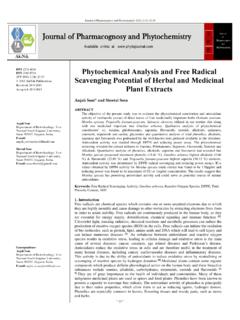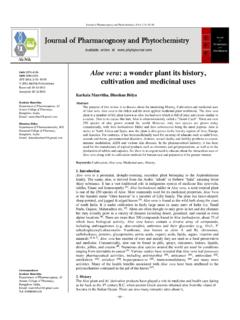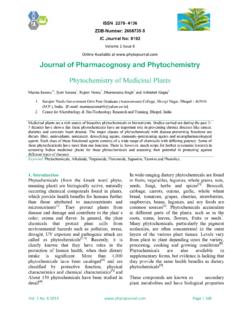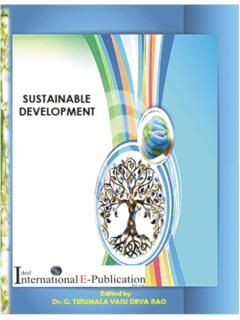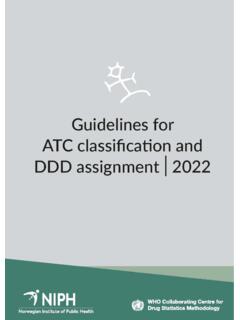Transcription of 2278-4136 Phytochemicals: Extraction methods ...
1 ~ 32 ~ Journal of Pharmacognosy and Phytochemistry 2017; 6(1): 32-36 E-ISSN: 2278-4136 P-ISSN: 2349-8234 JPP 2017; 6(1): 32-36 Received: 07-11-2016 Accepted: 08-12-2016 Krishnananda P Ingle Biotechnology Centre, Dr. Panjabrao Deshmukh Krishi Vidyapeeth, Akola, Maharashtra, Mumbai, India Amit G Deshmukh Assistant Professor, Nagarjuna medicinal and Aromatic Plant Division, Dr. Panjabrao Deshmukh Krishi Vidyapeeth, Akola, Maharashtra, Mumbai, India Dipika A Padole Biotechnology Centre, Dr. Panjabrao Deshmukh Krishi Vidyapeeth, Akola, Maharashtra, Mumbai, India Mahendra S Dudhare Assistant Professor, Vasantrao Naik College of Agril.
2 Biotechnology, Dr. Panjabrao Deshmukh Krishi Vidyapeeth, Yavatmal, Maharashtra, Mumbai, India Mangesh P Moharil Biotechnology Centre, Dr. Panjabrao Deshmukh Krishi Vidyapeeth, Akola, Maharashtra, Mumbai, India Vaibhav C. Khelurkar Biotechnology Centre, Dr. Panjabrao Deshmukh Krishi Vidyapeeth, Akola, Maharashtra, Mumbai, India Correspondence Krishnananda P Ingle Biotechnology Centre, Dr. Panjabrao Deshmukh Krishi Vidyapeeth, Akola, Maharashtra, Mumbai, India Phytochemicals: Extraction methods , identification and detection of bioactive compounds from plant extracts Krishnananda P Ingle, Amit G Deshmukh, Dipika A Padole, Mahendra S Dudhare, Mangesh P Moharil and Vaibhav C.
3 Khelurkar Abstract Plants are recognized in the pharmaceutical industry due to their broad spectrum of structural diversity and their wide range of pharmacological activities. The biological active compounds that are present in plants referred as phytochemicals. These phytochemicals derived from different parts of plants such as leaves, barks, seed, seed coat, flowers, roots and pulps and thereby used as sources of direct medicinal agents. Phytochemistry describes the large number of secondary metabolic compounds present in the plants.
4 The plants are the reservoirs of naturally occurring chemical compounds and of structurally diverse bioactive molecules. The Extraction of bioactive compounds from the plants and their quantitative and qualitative estimation is important for exploration of new biomolecules to be used by pharmaceutical and agrochemical industry directly or can be used as a lead molecule to synthesize more potent molecules. This review mostly highlighted on the analytical methodologies, which includes the Extraction methods and the analysis of bioactive compounds present in the plant extracts through the various techniques involving the applications of chromatographic techniques such as HPLC (High Performance Liquid Chromatography), TLC (Thin Layer Chromatography), HPTLC (High Performance Thin Layer Chromatography), OPLC (Optimum Performance Laminar Chromatography), GC (Gas Chromatography), PC (Paper Chromatography), CC (Column Chromatography)
5 And it s detection through Fourier Transform Infra-Red spectroscopy (FTIR), Nuclear Magnetic Resonance (NMR), and Mass Spectrometry (MS). Keywords: HPLC (High Performance Liquid Chromatography),TLC (Thin Layer Chromatography), HPTLC (High Performance Thin Layer Chromatography), OPLC (Optimum Performance Laminar Chromatography), GC (Gas Chromatography), PC (Paper Chromatography), CC (Column Chromatography) and it s detection through Fourier Transform Infra-Red spectroscopy (FTIR), Nuclear Magnetic Resonance (NMR), Mass Spectrometry (MS). 1. Introduction Natural products, such as plants extract, open a new horizon for the discovery of new therapeutic agents [1].
6 The use of traditional medicine and medicinal plants in most developing countries, as a normative basis for the maintenance of good health, has been widely observed and about 80% of the world s population relies on herbal medicines [2]. Plants contain a wide range of chemical compounds that can be used to treat chronic as well as infectious diseases3. Microbial resistance to the chemically synthesized drugs compelled us to move towards the ethnopharmacognosy. They found literally thousands of phytochemicals proved beneficial and have biological activity such as anticancer, antimicrobial, antioxidant, ant diarrheal, analgesic and wound healing activity were reported.
7 This paper mostly highlighted on the analytical methodologies, which includes the Extraction methods and the analysis and identification of bioactive compounds present in the plant extracts through the various techniques involving the applications of chromatographic techniques and some detection methods . Extraction methods for studying phytochemicals Extraction from the plant is an empirical exercise since different solvents are utilized at varying conditions such as time and temperature of Extraction . As bioactive components extracted from the plants further their separation from co extractives compounds is essential.
8 Further fractionation of extracted compounds done on the basis of their acidity, polarity or molecular size. The Extraction methods mostly used has been discussed below: Cold Extraction method: The different plants parts dried in an artificial environment at low temperature (50-60 C) and dried powder then further used for Extraction purpose using various solvents. Weigh the dried powder and added into conical flask with respective solvents and allow keeping at room ~ 33 ~ Journal of Pharmacognosy and Phytochemistry temperature for thirty minute shaking after each twenty four hours for seven days.
9 Finally filter the extract using whatman filter paper under vacuum and dry it at room temperature in watch glass dish. Note down the weight of each dish prior to drying of the extracts and after drying too. Calculate the weight of the extract from the difference [4]. Solvent Extraction method Universal Extraction System (Buchi) is recently used for solvent Extraction . The dried powder of various plant parts placed in glass thimble for Extraction purpose using various solvents. The procedures is carried out for 10 cycles for each extract and adjusts the temperature just below the boiling point of the respective solvents.
10 The resulting solvent extract is filtered, concentrated in vacuum concentrator and used to determine the presence of phytoconstituents [4]. Supercritical fluid Extraction (SFE) Supercritical Fluid Extraction (SFE) involves use of gases, usually CO2, and compressing them into a dense liquid. This liquid is then pumped through a cylinder containing the material to be extracted. From there, the extract-laden liquid is pumped into a separation chamber where the extract is separated from the gas and the gas is recovered for re-use. Solvent properties of CO2 can be manipulated and adjusted by varying the pressure and temperature.


